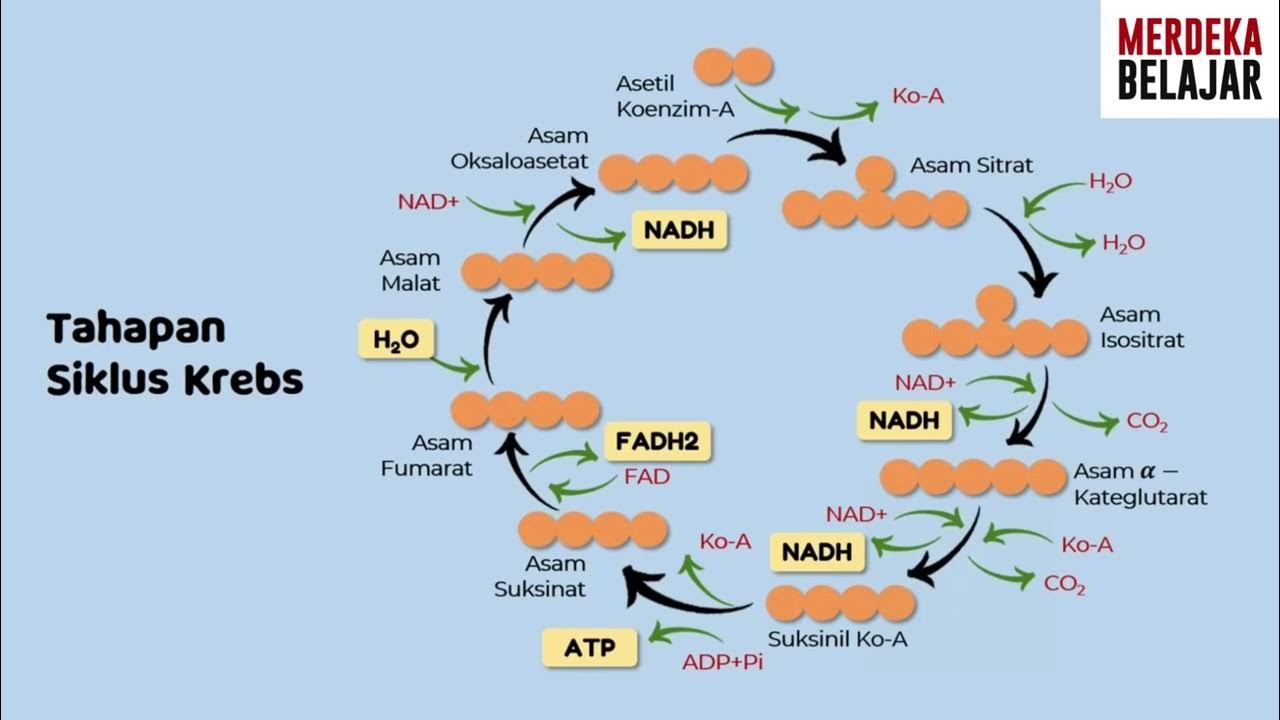TAHAPAN SIKLUS KREBS|Jembatan Keledai
Summary
TLDRThe script explains the third stage of aerobic cellular respiration, the Krebs cycle, named after its discoverer, Sir Hans Adolf Krebs. It occurs in the mitochondrial matrix and involves eight steps, producing citrate from acetyl-CoA and oxaloacetate. The cycle includes isomerization, decarboxylation, and electron transfer to NAD+ and FAD, resulting in the formation of NADH, FADH2, and ATP. The script details each step, highlighting the enzymes and reactions that lead to the production of energy-rich molecules essential for cellular functions.
Takeaways
- 🧬 The script discusses the third stage of aerobic cellular respiration, known as the Citric Acid Cycle or Krebs Cycle.
- 🔬 The cycle is named after Sir Hans Adolf Krebs, a German-British biochemist who discovered it.
- 🌐 The Citric Acid Cycle occurs in the mitochondrial matrix and is also referred to as the Krebs Cycle or the Tricarboxylic Acid (TCA) Cycle.
- 🔋 The cycle consists of eight steps, each involving different chemical reactions and enzymes.
- 🔬 The first step involves the condensation of acetyl-CoA with oxaloacetate to form citrate, releasing CoA in the process.
- 🔄 Isomerization occurs in the second step, converting citrate to isocitrate, which is catalyzed by the enzyme aconitase.
- ➖ During the third step, isocitrate is converted to alpha-ketoglutarate, releasing electrons that are captured by NAD+ to form NADH.
- 🔋 The fourth step involves decarboxylation, reducing the carbon count and producing carbon dioxide, catalyzed by isocitrate dehydrogenase.
- 🔬 In the fifth step, alpha-ketoglutarate is transformed into succinyl-CoA, which involves the addition of a CoA group and is catalyzed by alpha-ketoglutarate dehydrogenase.
- ↔️ The sixth step sees the conversion of succinyl-CoA to succinate, with the release of CoA and the formation of GTP or ATP, depending on the cell type.
- 🔋 The seventh step involves the conversion of succinate to fumarate, with the help of succinate dehydrogenase, and the production of FADH2.
- 🔄 The final step, catalyzed by malate dehydrogenase, converts malate back to oxaloacetate, completing the cycle and producing NADH.
Q & A
What is the third stage of aerobic cellular respiration called?
-The third stage of aerobic cellular respiration is called the Krebs cycle, also known as the citric acid cycle.
Who is the Krebs cycle named after?
-The Krebs cycle is named after Sir Hans Adolf Krebs, a German and English biochemist.
What is another name for the Krebs cycle?
-The Krebs cycle is also known as the citric acid cycle because it produces citrate.
Where does the Krebs cycle take place within the cell?
-The Krebs cycle takes place in the mitochondrial matrix.
How many stages are there in the Krebs cycle?
-There are eight stages in the Krebs cycle.
What is the first substrate to enter the Krebs cycle?
-The first substrate to enter the Krebs cycle is acetyl-CoA, which is a result of oxidative decarboxylation.
What is the role of isocitrate dehydrogenase in the Krebs cycle?
-Isocitrate dehydrogenase catalyzes the conversion of isocitrate to alpha-ketoglutarate, releasing electrons that are picked up by NAD+ to form NADH.
What is the product of the decarboxylation of alpha-ketoglutarate in the Krebs cycle?
-The product of the decarboxylation of alpha-ketoglutarate is succinyl-CoA.
What is the role of succinate dehydrogenase in the Krebs cycle?
-Succinate dehydrogenase catalyzes the conversion of succinate to fumarate, capturing electrons to form FADH2.
What is the final product of the Krebs cycle?
-The final product of the Krebs cycle is oxaloacetate, which can be used to start the cycle again.
How many ATP molecules are produced per turn of the Krebs cycle?
-One turn of the Krebs cycle produces one ATP (or GTP), three NADH, and one FADH2.
Outlines

This section is available to paid users only. Please upgrade to access this part.
Upgrade NowMindmap

This section is available to paid users only. Please upgrade to access this part.
Upgrade NowKeywords

This section is available to paid users only. Please upgrade to access this part.
Upgrade NowHighlights

This section is available to paid users only. Please upgrade to access this part.
Upgrade NowTranscripts

This section is available to paid users only. Please upgrade to access this part.
Upgrade Now5.0 / 5 (0 votes)





